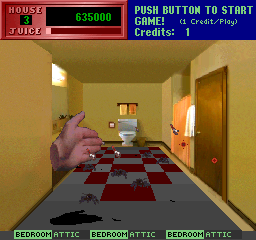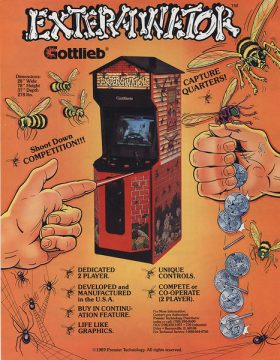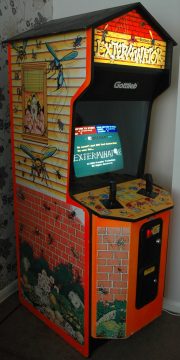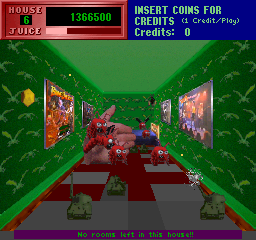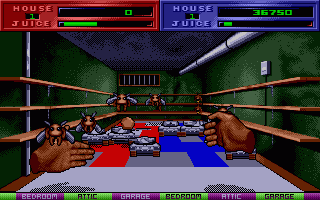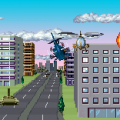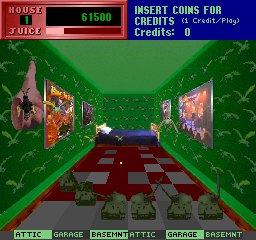Gottlieb has always been a household name in the field of pinball tables and amusement machines, but much less so in the world of arcade coin-ops, where they are only remembered for Q*bert. The swearing orange weirdo is still fairly recognizable to this day, but all of Gottlieb’s few other coin-ops have been forgotten, despite getting made during the “golden age of arcades” and being well-regarded at the time. Exterminator, their very last one, released under the Premier Technology company (the only one that ever appeared under that brand, which was specialized in pinball tables), was designed and programmed mostly by Warren Davis, the same developer behind Q*bert. Despite this, it never was a big hit with arcade owners or gamers. That might have to do with the machine having a complex custom printed circuit board, designed to handle the game’s advanced graphics, that broke often. Or the fact that the dedicated cabinet was produced in only around 250 copies, while conversion kits were way more popular. Or maybe because it was such a dang weird game.
For starters, it was possibly the very first arcade game whose graphics were entirely composed of digitized elements, most notably the photos used as textures of the stages’ walls. Its big dedicated cabinet was also shaped like a house, complete with roof and chimney, and fully decorated with pictures of a screaming woman at the window being surrounded by huge, creepy bugs and other critters. That art, plus the game logo in the attract mode being formed by bones and a laughing skull floating together, seems to suggest some sort of horror C-movie-inspired game. In actuality, it is much goofier than that: the titular Exterminator is a floating disembodied hand that can shoot beams from its index finger (actually bug spray, according to the user’s manual) and goes around the suburbs (apparently being able to drive a van all by itself. What is this, the Addams Family?) to rid them from a horde of vermin and assorted stuff including walnuts, soda cans and toy tanks. Doesn’t make much sense, but, as a coin-op from the 80s, it doesn’t have to.
The surreal nature of the game contrasts with the (for the time)realistic-looking settings. However, for whatever reason, while some of the pests were rendered in a fairly lifelike way, others are of the cartoony sort you can see, for example, drawn on a can of bug spray. There are only two BGM for the entire game, a rendition of “Flight of the Bumblebee” (appropriately enough) and a more military-sounding tune used whenever the toy tanks appear. There are even a couple of “Easter eggs” related to Gottlieb, with two posters in the bedroom levels being the art for their pinballs Bone Busters and Rock Encore.
The gameplay, too. is unique and somewhat convoluted: each house is made of five rooms viewed from a 3-D perspective, each room has its floor divided into a grid of tiles, and pests both air-based (mosquitoes, moths, dragonflies…) and ground-based (spiders, mice, frogs…) spawn endlessly from the back of the room. Killing them causes the floor tiles they die on to change color, though some are already colored in when the stage starts, and you have to crush enough of them so that a vertical lane of tiles will change color entirely. Each of these lanes has a room’s name (garage, nursery, attic, etc.) written below it, so filling a lane with color takes you to said room(after a psychedelic woosh and a score tally of every tile colored in), until every one of the rooms is completed and the hand hops on its van to face the next house, rinse and repeat. And once all of the suburb’s seven houses have been freed from the pests, it’s time for the “Ultimate Challenge”: the hand is in a grassy open field and has to destroy wave upon wave of enemy critters, and managing to survive nets you 500K bonus points, the usual lame single-screen congratulation text and the “privilege” to start it all over again. But if you fail you will have to replay the seventh house, over and over again. Luckily, there are a couple secret spots you can shoot with your finger-gun to activate the warp zone and skip some of these houses while gaining a ton of points in the process. There’s also the simultaneous 2-player option, where each hand paints the tiles in different colors (red or blue) and players can compete to see who can finish a room first.
The hand moves in eight directions, controlled by a rotary joystick, and has three ways to defeat enemies: grabbing the flying ones when they get close enough, shooting them with finger lasers when they are far away, or turning into a fist to squash the ground-based ones while they are on the tile directly below it. Grabbing and shooting is done by pushing the button on top of the joystick, and slamming the fist by pressing the dedicated “Pound” button on the panel. All enemies and the hand have shadows, but it’s still fairly difficult to judge their positions. Shooting is only allowed when the hand is at the edge (left for P1 or right for P2) of the screen, and tilting the joystick while the button is pressed aims the direction of the beams. Also you can’t just spam the “Pound” action whenever, but have to be at a certain height to slam the ground pests, or the game will notice you of that. Apparently though, there was a much rarer ROM set that allowed the hand to shoot whenever, thus turning the game into a much easier and more conventional (but no less bizarre) shooting gallery.
From the very first stage to the end of the game there is an enemy, the wasp, that will sting the hand if grabbed or left alone too much, making it lose energy, referred to as “Juice” for some reason. You have to waggle the joystick in order to momentarily make it go away. Other hazards like tanks’ bullets or the dragonflies’ bombs will drain said “Juice”, and the only way to replenish it is to grab flying, flashing dodecahedrons (?), or the squirt bottles that appear in every room from the second house on and will attack the hand with its own “lasers”. After every few levels there are also bonus stages where you just have to destroy everything that moves in a limited time, without having to worry about tiles or hazards: easier said than done. The very nature of the game makes it so that stages can be completed in a few seconds if you’re quick enough to grab and pound enemies and to take advantage of the already colored tiles; but it also means that you can get a game over in seconds, too, since there are no extra lives and often there is too much stuff going on at the same time. And, after the first few houses, graphics and enemies always repeat themselves, just in different combinations, so you’ve seen everything that Exterminator has to offer halfway through. Basically, it is a score-oriented quarter-muncher that features the kind of frantic, twitchy, complex yet really repetitive gameplay that was popular at the time of, say, Sinistar or Defender, but that had fallen out of favor since then.
The early 90s were a time when almost every moderately successful coin-op was converted for home systems and microcomputers, and Exterminator was no exception. All of the conversions were published by Audiogenic between 1990 and ‘91 (to add to the uniqueness of the game, this was the only arcade conversion they worked on) and developed by the famed British group The Assembly Line, coders specialized in 3D action-puzzle games that pushed computers to their limits. The graphic artists also came from another British group named Blue Turtle, whose claim to fame was supplying graphics for C64 and Spectrum games.
With those names behind them, it’s clear why all of the conversions were actually quite well-made and faithful to the original arcade, despite the systems’ limitations and inability to handle digitized graphics. Actually, having all graphics being sprite-based instead of relying on digitized pictures makes the style of the game seem more coherent. And the 8-way joysticks of the home systems were less cumbersome than the arcade’s original control scheme, making the experience less awkward overall, despite some collision detection problems. The only missing thing is the simultaneous 2-player option on the 8-bit computers, but other than that everything is there, including the intermissions with the van moving from one house to another, even on less powerful machines like the ZX Spectrum. And every sprite is animated and moves fairly fluidly too. Another testament to the coders’ and artists’ ability. As for the audio, effects and music were handled generally well, too, though some versions only have the “Bumblebee” theme, and the Amiga and Atari ST conversions have the BGM reduced to an obsessive-sounding looped clip that lasts just a few seconds and adds to the game’s surreal, dreamlike (or nightmarish?) quality. Speaking of famous names, the C64 one also had an intro tune written by the popular composer David Whittaker.
Apparently Audiogenic decided to work on an in-house sequel, Exterminator 2, to be released around 1992. It would have featured the same basic gameplay but with new insects, hazards, secrets and bonus stages. However, despite some mentions in magazines of the time, nothing came of it and probably actual development never really started. So, the sequel’s failure ensured that really there never was and never will be another game quite similar to Exterminator.
Links
Battle of the Ports – YouTube video comparing all of the different ports of the game, plus some additional info in the comment section.
Arcade Museum – Info on the original arcade cabinet and mention of the alternate ROM set.
Lemon64 – Review of the C64 port.
Hall of Light–Database entry for the Amiga port, including mention of the unreleased/never developed sequel.
Andy’s Arcade – The image of the original cabinet comes from this page.
Screenshot Comparisons
